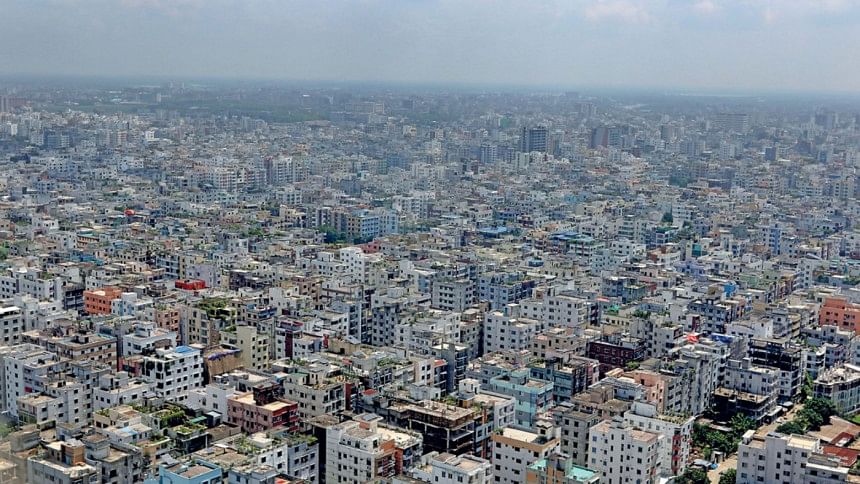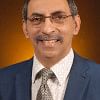Dhaka city’s unbridled expansion

Dhaka has been going through an unprecedented level of urban growth during the last five decades. As the capital of newly independent Bangladesh in 1971, Dhaka had a population of only 1.5 million, whereas it currently has an estimated population of 21.7 million. Along with its population, the city has also grown spatially in all directions. However, the total built-up area of the city has not kept pace with its population growth. Natural population growth and higher levels of in-migration, fuelled by improved economic status of the people on the one hand and rural poverty on the other, are behind an average four percent annual growth of Dhaka's population over the last three decades. The city contributes about a quarter of the country's income.
Dhaka city's expansion is caused by a mixture of planned and unplanned development. The Structure Plan, formulated by RAJUK (capital development authority for Dhaka), foresees expansion of the city in all directions, by consuming sub-urban and agricultural land to meet the demand of future populations. However, on a closer look at the current trend of horizontal development of the city, one cannot deny the imminent danger of expansions encroaching into the flood zones, natural wetlands and canals in the near future.
By taking into consideration the present and planned road networks, employment opportunities, services and facilities, and natural barriers like lowland, rivers and canals, we can predict the physical expansion of the city in the next three decades. Of these, road networks play a very important role, since human habitation usually follows transportation networks. The roads and bridges built on the Buriganga and Dhaleswari rivers have resulted in massive development of residential and commercial establishments in both sides of the rivers. The waterways built in Jinjira and Keraniganj have helped in small-scale industrialisation and urban expansion as well. The export-oriented industrial establishments in Narayanganj, Kanchpur and Siddhirganj have extended development in the south-eastern part of Dhaka as goods are transported through the highway to Chattogram port. The low lying areas are being filled up and built on to enable establishment of residential buildings, various industrial enterprises and service facilities. But most of these are happening in an unplanned manner.
The concentration of industries starting from Mirpur, Ashulia and continuing through to Tongi, Joydevpur, Gazipur and Konabari, is influencing growth of the northern part of Dhaka city. In the north-western part, industries are growing rapidly in Aminbazar, Savar, Nabinagar and Manikganj areas. A new trend is the establishment of private universities in Gazipur, Savar, Ashulia and Bashundhara areas, intensifying urban growth further.
Dhaka's rapid growth is a concern that nobody denies. All the city authorities that are responsible for planning and providing services to the people are putting in efforts to catch up with the speed with which Dhaka is growing by building roads, drainage systems, flyovers, rapid mass transport, electricity and water supplies, and health and educational institutions—most of which are concentrated in the currently built up part of the city. Rapid population growth in the eastern part of the city calls for urgent attention by the planners and policymakers. RAJUK should carry out land use surveys and earmark areas for roads, residential, commercial and industrial zones, and all types of services and infrastructure, assuming lower density expansion compared to the already built-up areas, which have been spoiled by high population density, traffic congestion, lack of essential services and environmental degradation. Our sad experience with the unplanned parts of the city—with narrow lanes, high rise residential buildings, and a mixture of educational, health, commercial and residential uses of land—affect the environment of the whole city.
If the authorities seriously want, the eastern part of the city can still be saved from such a situation. The spontaneous development of east Dhaka will create the same problem if proper infrastructure and facilities are not built in a planned manner in the next few years. If residential and commercial building plans are approved by municipalities and union parishads before RAJUK prepares zonal plans, then the same type of housing construction around narrow streets might emerge and it will be extremely difficult to demolish them and widen the roads in future. Similarly, unchecked growth may also encroach upon the canals, rivers and lowlands, which are essential to maintain the quick flow of rain and flood water. The Bangladesh Inland Water Transport Authority has been demolishing illegal structures from the river banks and Dhaka South City Corporation has been removing unauthorised structures built on canals from time to time, but this is a painful thing to do. Time is running out fast—we need to do our best to check the unplanned growth of eastern Dhaka.
Three important east-west transport networks—which are, 300 feet road through Purbachal passing through Sylhet-Chattogram divisions, two segments of mass rapid transit lines and one bus rapid transport line—will make east Dhaka's nearly 100 square kilometre area more accessible. Also, Dhaka circular rail is planned to pass through Purbachal, which will facilitate easy travel from the eastern side. Proper flood protection systems along with adequate infrastructure have the potential to develop east Dhaka in a healthy manner.
We have to recognise that there is an essential difference between the physical growth of rural and urban areas. The physical growth of rural areas usually does not pose much threat to human and environmental conditions and therefore, does not require strict land use control and restrictions. But urban growth should be properly managed, since haphazard growth can lead to serious risks to millions of people and the environment, which can never be properly fixed. Like in any part of the world, urban development should always be guided and planned, land use strictly controlled, and density of population pre-established, to fit the volume of infrastructure, energy and services that are provided for the area. These are done by the use of legal instruments, master planning, land acquisition and land use restrictions. The urban authorities, service agencies, local government bodies, law enforcement systems, and above all, millions of city dwellers, should earnestly cooperate to establish a liveable, healthy and green city.
It has to be remembered that only the market mechanism should not be allowed to determine the growth of urban areas. First and foremost, urban areas, especially in a megacity like Dhaka, should be built on the consideration of easy movement of people through efficient transportation networks, healthy living, adequate number of schools, hospitals, parks and playgrounds, designated shopping areas, peaceful low-height residential areas, well-connected commercial centres, etc. Factories, industries and airports should be established far away from the city. There are certain standards that should be maintained in urban planning and development.
The unbridled opportunity of land speculation increases the land price and leads to high costs of doing business in urban areas. The land price in Dhaka has been increasing very fast, which is not a good thing for the economy. Urbanisation is a civic process and it should facilitate fair and competitive marketing of products on the one hand, and affordable living of the common people, on the other. All urban planning methods and techniques like public-private cooperation, land pulling, cost-sharing and efficient resource management should be employed, with the objective of achieving better living conditions for the citizens. Urban development strategies should not be reactive, but should be proactive. Collaboration of all urban actors like RAJUK, City Corporation, Roads and Highways Department, utility service providers, and chambers of commerce and businesses, are necessary to breathe life into the city. It will be a monumental task, no doubt, but the challenge should be met with strong determination. Streamlining Dhaka to me is like fixing half of the country's woes. There should be no excuse to put Dhaka city's causes on the back burner, since it pumps the economy's blood throughout the whole country.
Dr Nawshad Ahmed is an economist and urban planner.

 For all latest news, follow The Daily Star's Google News channel.
For all latest news, follow The Daily Star's Google News channel. 



Comments